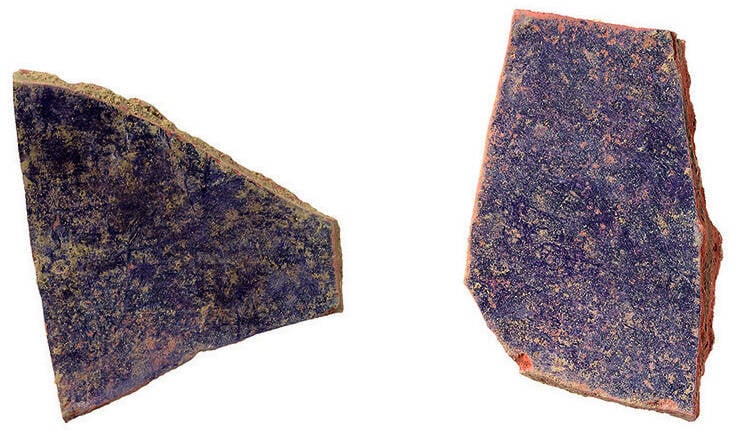The dye produced in this 3,600-year-old workshop was an expensive and rare pigment that was made from crushed sea snails and was worn by ancient elites.

Paris Lodron University of SalzburgThe Kolonna archaeological site on the Greek island of Aegina, along with the snail and resulting powder used to make the pigment known as Mycenaean purple.
A recent study has detailed the discovery of a Bronze Age dye workshop on the Greek island of Aegina. Analysis of the workshop uncovered crushed marine snails used to create the famed pigment known as Mycenaean purple (or Tyrian purple to the Romans), a color prized in antiquity for its vibrancy, rarity, and hefty price tag.
Alongside the snails, researchers also discovered tools and pottery fragments used to make and store the dye. Charred animal bones at the site also point to the possibility of ritualistic animal sacrifices to bless the production of the dye.
Overall, researchers are hopeful that this new find will unveil further information about trade and culture on Aegina and its role in the Mediterranean world during the Bronze Age.
Archaeologists Unearth A Bronze Age Workshop Used To Make Mycenaean Purple Dye

L. Berger/PLOS ONEA pit at the Aegina site where sea snails were crushed to make Mycenaean purple dye.
Archaeologists began their excavations on Aegina at the Bronze Age site Kolonna, located in the northwestern portion of the island, in 2015. There, archaeologists discovered the ruins of two buildings from the 16th century B.C.E. that had collapsed on top of each other.
In the older building, researchers discovered pottery fragments with well-preserved purple pigments. They also unearthed tools such as grinding stones and the crushed shells of marine snails.
Immediately, researchers realized they had discovered the ruins of an ancient dye workshop. For years, researchers knew that Bronze Age Aeginetans produced the purple dye, but they did not know where.
“We found relocated waste deposits (crushed snail shells transferred to different places) in different parts of the settlement, so we knew that the Aeginetans produced purple dye somewhere in or near the settlement, but we did not know exactly where,” Lydia Berger, the study lead from the Paris Lodron University of Salzburg, told All That’s Interesting in an email.
Most evidence of dye production in the Mediterranean included the use of marine snails. During the Bronze Age, dye makers would collect the mucus of these snails to create the vibrant purple color used in their prized pigments.
“To obtain the desired dye, the hypobranchial glands of the snails, either extracted by opening the shell or as a component of the fully crushed mollusk body, were mixed with some salt water and left steeping for a few days in suitable containers, vats, or vessels,” the archaeologists wrote in their study, recently published in PLOS ONE.
Chemical analysis of the pottery fragments and dyes revealed that the workshop exclusively worked with the banded dye-murex snail (Hexaplex trunculus), one of the three main marine snail species in the Mediterranean.
Researchers also unearthed the charred bones of many mammals, mainly piglets and lambs, which may have been used in ritualistic animal sacrifices to bless the workshop and ensure smooth production of the dye.
Highly-Prized Purple Dye In The Ancient World

L. Berger/PLOS ONESeveral pottery artifacts dyed with Mycenaean purple that were found at the Aegina site.
During the Bronze Age, the island of Aegina was a key player in the Aegean region. Its main settlement on the island was called Cape Kolonna.
According to Berger, the island was well-connected with the Aegean trade network during the first half of the second millennium B.C.E.
“Aeginetan pottery was traded to many regions of the Aegean world. And especially they had intensive contacts with Minoan Crete. In the Middle Bronze Age they imported not only products but also new technologies from Crete.”
The presence of this dye workshop paints an intriguing picture for archaeologists. During the Bronze Age, the purple dye produced by this workshop would have been a highly prized item.
Indeed, Mycenaean purple was incredibly expensive and rare, affordable only for elites. The process of making it likely required 12,000 marine snails to produce just one gram of dye, not taking into account the hundreds of hours of labor required to catch the snails, process them in the workshop, and then properly make the pigment.
It was so precious that it was once worth more than gold and even inspired a Roman law mandating that it only be worn by the emperor, according to the University of Chicago.
Its origins date back to the Phoenicians of the Levant. This dye was most famously produced in a workshop in Tyre, Lebanon — hence the Roman name Tyrian purple.
Archaeologists’ discovery of this dye workshop in Aegina has provided them with more information about the island’s role in the ancient world and what type of trade relations existed between it and other areas in the Mediterranean thousands of years ago.
After reading about this Mycenaean purple dye workshop, learn about the piece of Tyrian purple dye that was recently found in England. Then, discover some of the most fascinating facts about ancient Greece.





